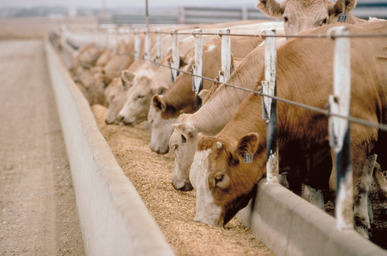Cattle, Calves, and Beef

Image courtesy of http://crossfitfire.com/site/wp-content/uploads/2009/08/Feedlot-Cattle.jpg
Many people across America sit down to steaks, pot roast, and roast beef for dinner, never wondering how their beef came from farm to table. With the price of meat rising, customers pay even more than they did several years ago for prime cuts of beef such as New York Boneless Strip Steak. Because of the horrendous conditions in CAFOs and feed lots, in addition to the economic laws of supply and demand, it seems a little obvious as to why a farmer might use antibiotics throughout the growing process. The more animals approved for slaughter, the larger the profit the farmer takes home. Knowing the following information about beef commercially raised with antibiotics, judge for yourself whether you really want to eat that next steak.
· Calves leave for feedlots after they reach only seven months old
· In feed lots, many calves die because of avoidable medical
conditions such as pneumonia and diarrhea
o To combat these problems, farmers sometimes give the entire group of calves antibiotics
· Farmers use antibiotics to treat “Shipping fever complex”, a large-scale problem with cattle in many CAFOs/feedlots.
· Antibiotics have also been used in cattle to:
o Manage “liver abscesses”
o Speed up growth
o Thwart or treat the onset of Respiratory Disease (McEwen and Fedorka-Cray s94-95).
In 1999 alone, approximately 83% of cattle in feed lots received some form of antibiotics for purposes of disease prevention or enhancing growth (s94).
· Calves leave for feedlots after they reach only seven months old
· In feed lots, many calves die because of avoidable medical
conditions such as pneumonia and diarrhea
o To combat these problems, farmers sometimes give the entire group of calves antibiotics
· Farmers use antibiotics to treat “Shipping fever complex”, a large-scale problem with cattle in many CAFOs/feedlots.
· Antibiotics have also been used in cattle to:
o Manage “liver abscesses”
o Speed up growth
o Thwart or treat the onset of Respiratory Disease (McEwen and Fedorka-Cray s94-95).
In 1999 alone, approximately 83% of cattle in feed lots received some form of antibiotics for purposes of disease prevention or enhancing growth (s94).
Poultry
More than just nuggets, breasts, wings, and thighs, various forms of poultry commercially raised for slaughter also receive metaphylactic, prophylactic, and subtherapeutic doses of antibiotics. Not unlike their four legged counterparts, concerns exist over poultry raised with antibiotics. In commercially raised poultry…
· Antibiotics treat Coccidiosis, a disease caused by parasites commonly found in feedlot poultry (s93)
o To combat Coccidiosis, farmers use antibiotics in the poultry's food (s93)
o Starting after the chicks are born, farmers feed poultry food containing three kinds of antibiotics, one to prevent Coccidiosis, one to enhance growth, and a third known as an “organic arsenical compound” which contains the properties of the first two antibiotics (The Use of Drugs in Food Animals 34).
· Since many diseases occur in feedlots, farmers use antibiotics to help manage and stop the spread of “infectious diseases”. Some of these diseases include “Salmonella, E. coli, and Clostridium” (38).
· Farmers use antibiotics to cure sick birds through their drinking water (34).
· Several factors have influenced the decline of antibiotic use in poultry, these factors include:
o Better disease prevention in conjunction with genetic selection
o A fewer number of antibiotics can effectively treat respiratory disease
o Slightly improved poultry living conditions and the removal of sick animals have led to a decline in antibiotic use
o Antibiotic use has declined with efforts to reduce antibiotic residues in poultry
o New advances in medicine development, especially with respect to developments in vaccines (35).
· Antibiotics treat Coccidiosis, a disease caused by parasites commonly found in feedlot poultry (s93)
o To combat Coccidiosis, farmers use antibiotics in the poultry's food (s93)
o Starting after the chicks are born, farmers feed poultry food containing three kinds of antibiotics, one to prevent Coccidiosis, one to enhance growth, and a third known as an “organic arsenical compound” which contains the properties of the first two antibiotics (The Use of Drugs in Food Animals 34).
· Since many diseases occur in feedlots, farmers use antibiotics to help manage and stop the spread of “infectious diseases”. Some of these diseases include “Salmonella, E. coli, and Clostridium” (38).
· Farmers use antibiotics to cure sick birds through their drinking water (34).
· Several factors have influenced the decline of antibiotic use in poultry, these factors include:
o Better disease prevention in conjunction with genetic selection
o A fewer number of antibiotics can effectively treat respiratory disease
o Slightly improved poultry living conditions and the removal of sick animals have led to a decline in antibiotic use
o Antibiotic use has declined with efforts to reduce antibiotic residues in poultry
o New advances in medicine development, especially with respect to developments in vaccines (35).
Pigs/Swine

Image from:http://soci3407.info/wp-content/uploads/2009/05/20090507-factory-farm-01.jpg
Additionally, farmers also make use of antibiotics by placing them in swine’s feed. Growers typically begin administering low doses of these antibiotics immediately after pigs can eat solid food, for purposes of growth enhancement and preventing illness (McEwen and Fedorka-Cray s96). As in many feedlots, diseases such as pneumonia, bacterial diarrhea, swine dysentery, and ileitis can run rampant, posing major problems for those in charge of feedlots. To combat these diseases, workers administer antibiotics therapeutically through a pig’s food (s96).
Fish
Yes, even farmed fish receive antibiotics! However, unlike pigs, poultry, and cattle, farmers cannot give farmed fish any antibiotics for growth enhancement (s96). The two antibiotics approved for therapeutic treatment of disease (ormetoprim-sulfadiazine and oxytetracycline) have usually been administered in a metaphylactic fashion, although one can administer them to single fish (s96).
